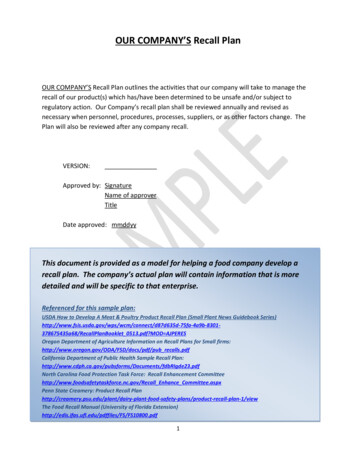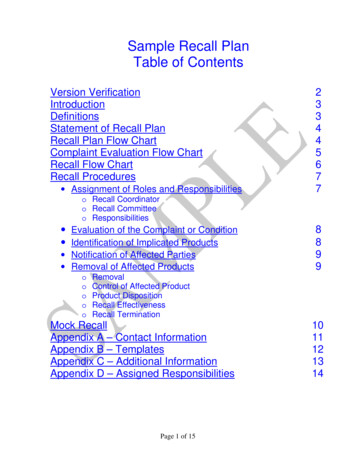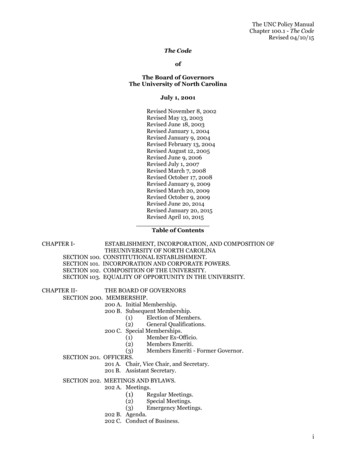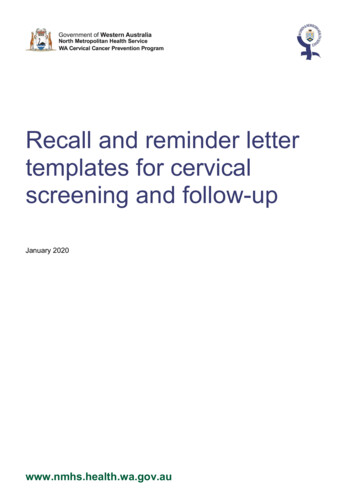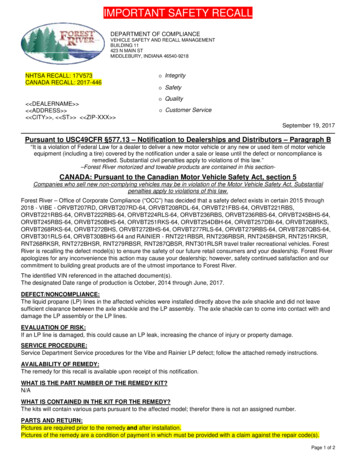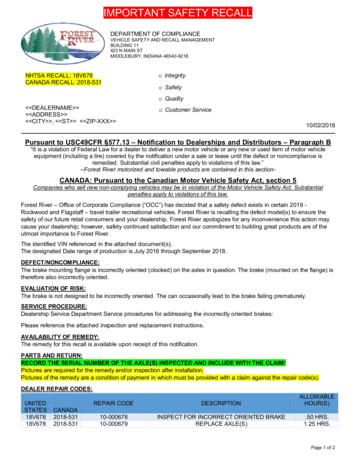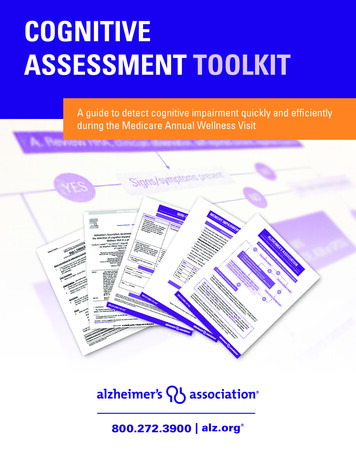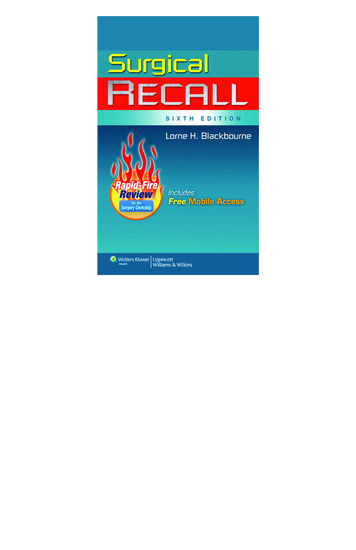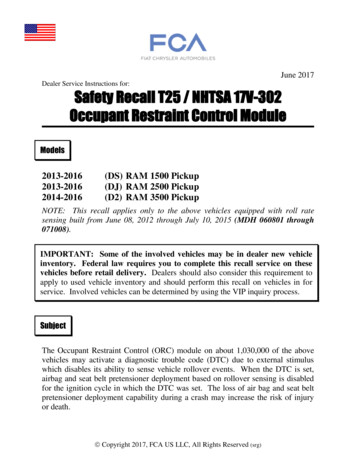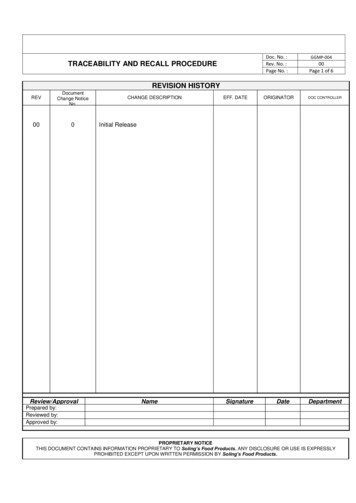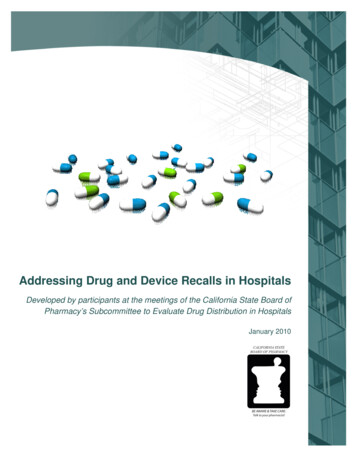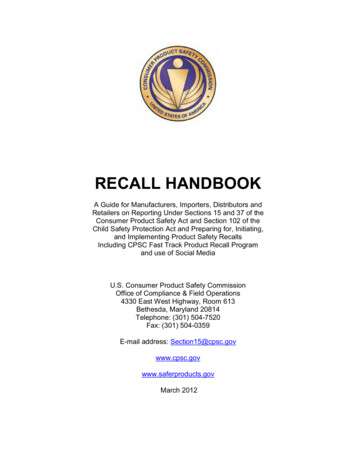
Transcription
RECALL HANDBOOKA Guide for Manufacturers, Importers, Distributors andRetailers on Reporting Under Sections 15 and 37 of theConsumer Product Safety Act and Section 102 of theChild Safety Protection Act and Preparing for, Initiating,and Implementing Product Safety RecallsIncluding CPSC Fast Track Product Recall Programand use of Social MediaU.S. Consumer Product Safety CommissionOffice of Compliance & Field Operations4330 East West Highway, Room 613Bethesda, Maryland 20814Telephone: (301) 504-7520Fax: (301) 504-0359E-mail address: vMarch 2012
ForewordThe U.S. Consumer Product Safety Commission (CPSC) Office of Complianceand Field Operations staff prepared this Recall Handbook to help your companyunderstand your obligations and responsibilities under the Consumer ProductSafety Act. It applies to you if you manufacture, import, distribute, or retailconsumer products. The latest revision of this Handbook incorporates changes tothe statute as a result of the Consumer Product Safety Improvement Act.No company likes to recall one of its products, but when a safety problem makesa product recall necessary to prevent injuries and save lives, it benefits everyoneto move quickly and effectively.Our staff is constantly striving to improve both the timeliness of recalls and theeffectiveness of the recall programs negotiated with companies. Our Fast TrackProduct Recall Program and use of Social Media to reach consumers in theevent of a recall is helping both of these efforts. The Fast Track Product RecallProgram is designed for companies willing and able to move quickly with avoluntary recall of their product. The program, described in detail in Section IV,eliminates some of the procedural steps in the traditional recall process, includinga staff preliminary determination that the product contains a defect that presentsa substantial product hazard.Many companies have used the Fast Track Product Recall program since CPSCintroduced it in August 1995 and have found it to be a useful way to expediteproduct safety recalls.We welcome your comments on the Fast Track Product Recall Program or anyother information in this handbook.Office of Compliance and Field Operations301-504-7520Section15@cpsc.gov2
RECALL HANDBOOKBackgroundI. Reporting RequirementsA. Section 15 Reports1. What and Where to Report2. When to Report3. Confidentiality of ReportsB. Section 37 Reports1. What to Report2. When and Where to Report3. Confidentiality of ReportsC. Section 1021. What to Report2. When and Where to Report3. Confidentiality of ReportsII. Identifying a DefectIII. CPSC Evaluation of Section 15 Reports Class A HazardsClass B HazardsClass C HazardsIV. Fast Track Product Recall ProgramV. Putting Together a Corrective Action PlanA. Preparing for a Product RecallB. Elements of a RecallVI. Communicating Recall InformationA.B.C.D.News ReleasesVideo News ReleasesPostersSocial media3
E. Other Forms of NoticeF. Toll-Free NumbersVII. Monitoring Product RecallsVIII. Developing a Company Policy and Plan to Identify Defective Products and toUndertake a Product RecallA. Designating a Recall CoordinatorB. Role of the Recall CoordinatorIX. Records MaintenanceA.B.C.D.E.Records of complaints, warranty returns, insurance claims, lawsuitsProduction RecordsDistribution RecordsQuality Control RecordsProduct Registration CardsX. Conclusion4
RECALL HANDBOOK1BackgroundThe U.S. Consumer Product Safety Commission (CPSC) is an independentregulatory agency responsible for protecting the public from unreasonable risksof injury and death associated with consumer products. Established by Congressin the Consumer Product Safety Act (CPSA), 15 U.S.C. §§ 2051-2089, the CPSChas jurisdiction over approximately 15,000 different types of products used in andaround the home, in schools, in recreation, and otherwise ("consumerproducts").2This handbook is for companies that manufacture, import, distribute, retail, orotherwise sell consumer products. It has three purposes: (1) to familiarizecompanies with their reporting requirements under sections 15(b) and 37 of theCPSA, 15 U.S.C. § 2064(b) and § 2084, and Section 102 of the Child SafetyProtection Act, Pub. L. 103-267, 108 Stat. 722, 6/16/94; (2) to help companieslearn how to recognize potentially hazardous consumer products at an earlystage; and (3) to assist firms that discover they have manufactured, distributedor retailed such products to develop and implement "corrective action plans" thataddress the hazards. The term "corrective action plan" (CAP) generally includesany type of remedial action taken by a firm. A CAP could, for example, providefor the return of a product to the manufacturer or retailer for a cash refund or areplacement product; for the repair of a product; and/or for public notice of thehazard. A CAP may include multiple measures that are necessary to protectconsumers. The Commission staff refers to corrective actions as "recalls"because the public and media more readily recognize and respond to thatdescription.3This handbook is not an all-inclusive reference source of information describinghow to recall products. The goal of a corrective action plan should be to retrieveas many hazardous products from the distribution chain and from consumers asis possible in the most efficient, cost-effective manner. Reaching this goal oftenrequires creative planning. Companies developing specific corrective actionplans to address unsafe or potentially unsafe products typically work closely withthe Commission staff to take advantage of the staff's expertise in designing andcarrying out such plans. This results in greater protection for consumers againstinjury or death.5
1This handbook does not replace the Commission's statutes or interpretative regulations set outin 16 C.F.R. Parts 1115, 1116, and 1117. If there is any discrepancy, the statutes and regulationssupersede this handbook. This material is available on the CPSC web site at:http://www.cpsc.gov .2The Commission does not have jurisdiction over foods, drugs, cosmetics, medical devices,firearms and ammunition, boats, motor vehicles, aircraft, or tobacco. Specific questions about theCommission's jurisdiction over particular products should be directed to the Office of the GeneralCounsel.3This handbook uses the term "recall" to describe any repair, replacement, refund, ornotice/warning program.I. Reporting Requirements.A. Section 15 ReportsSection 15(b) of the Consumer Product Safety Act establishes reportingrequirements for manufacturers, importers, distributors and retailers of consumerproducts, or other product or substances distributed in commerce over which theCommission has jurisdiction. Each must notify the Commission immediately if itobtains information which reasonably supports the conclusion that a productdistributed in commerce (1) fails to comply with an applicable consumer productsafety rule or with a voluntary consumer product safety standard upon which theCommission has relied under section 9, (2) fails to comply with any other rule,regulation, standard or ban under the CPSA or any other Act enforced by theCommission, including the Flammable Fabrics Act, 15 U.S.C. §1193-1204; theFederal Hazardous Substances Act, 15 U.S.C. § 1261-1278; the Children’sGasoline Burn Prevention Act, 110 Public Law 278 (July 17, 2008), the VirginiaGraeme Baker Pool and Spa Safety Act, 110 Public Law 140 (with amendments),the Poison Prevention Packaging Act, 15 U.S.C. § 1471-1476, and theRefrigerator Safety Act; 15 U.S.C. § 1211-1214; (3) contains a defect whichcould create a substantial product hazard, or (4) creates an unreasonable risk ofserious injury or death. The Commission has issued an interpretive regulation, 16C.F.R. Part 1115 that further explains a reporting company's obligations.In enacting section 15(b), Congress intended to encourage the widespreadreporting of timely, accurate and complete information that is necessary toprotect public health and safety. In addition to assisting the Commission todiscover substantial product hazards, reporting would identify risks of injury thatthe Commission could address through voluntary or mandatory standards, orinformation and education.Although CPSC uses sources other than company reports to identify potentiallyhazardous products, reporting by companies under section 15 can provide themost timely and effective source of information about such products. This is6
because firms often learn of potential product safety problems at an early stage.For this reason, companies involved in the manufacture, importation, distribution,or sale of consumer products should develop a system for maintaining andreviewing information about their products that might suggest that their producthas a defect or poses an unreasonable risk of serious injury or death. Suchinformation includes, but is not limited to, consumer complaints, warranty returns,insurance claims or payments, product liability lawsuits, reports of productionproblems, product testing, or other critical analyses of products.Reporting a product to the Commission under section 15 does notautomatically mean that the Commission will conclude that the productcreates a substantial product hazard or that corrective action is necessary.The CPSC staff will evaluate the report and works with the reporting firm todetermine if corrective action is appropriate. Many of the reports received requireno corrective action because the staff concludes that the reported product defectdoes not create a substantial product hazard.4As of January 2012, there were two such standards—the voluntary standards for chain saws andfor unvented gas space heaters, See, Appendix to Part 1115, Voluntary Standards on Which theCommission Relied Under Section 9 of the Consumer Product Safety Act .1. What and Where to ReportA company should file its report with the Office of Compliance and FieldOperations. The report should be filed electronically through the CPSC website(SaferProducts.gov). Alternatively, a firm can file its request by mail or telephone(301-504-7520). A company should assign the responsibility of reporting tosomeone with knowledge of the product and of the reporting requirements ofsection 15. That individual should have the authority to report to CPSC or toquickly raise the reporting issue to someone who does.Reporting firms should be prepared to provide the information described below.However, no company should delay a report because some of this information isnot yet available. The following information should be transmitted: identification and description of the product;name and address of the manufacturer and/or importer of the product ifknown. If not known, then the names and addresses of all knowndistributors and retailers of the product;nature and extent of the possible defect, the failure to comply, or the risk;nature and extent of injury or risk of injury associated with the product;name and address of the person informing the Commission;if reasonably available, the other information specified in Section1115.13(d) of the Commission's regulations; anda timetable for providing information not immediately available;7
Retailers and distributors may satisfy their reporting obligations in the mannerdescribed above. Alternatively, a retailer or distributor may send a letter to themanufacturer or importer of a product describing the noncompliance with anapplicable regulation, defect, or risk of injury or death associated with the productand forward a copy of that letter to the Office of Compliance and FieldOperations. A distributor or retailer may also satisfy their reporting obligations byforwarding to the Office of Compliance and Field Operations reportableinformation received from another firm. Section 15(b) requires that amanufacturer, retailer, or distributor must immediately inform the CPSC of afailure to comply, a defect, or such a risk unless it has actual knowledge that theCommission has been adequately informed of such failure to comply, defect orrisk.2. When to ReportSection 15 requires firms to report "immediately." This means that a firm shouldnotify the Commission within 24 hours of obtaining information described insection A.1 ("What and Where to Report") above. Guidelines for determiningwhether a product defect exists, whether a product creates an unreasonable riskof serious injury or death, and whether a report is necessary or appropriate areprovided in 16 C.F.R. § 1115.12. Section II of this handbook does the same.A company must report to the Commission within 24 hours of obtainingreportable information. The Commission encourages companies to reportpotential substantial product hazards even while their own investigations arecontinuing. However, if a company is uncertain whether information is reportable,the firm may spend a reasonable time investigating the matter. That investigationshould not exceed 10 working days unless the firm can demonstrate that a longertime is reasonable in the circumstances. Absent such circumstances, theCommission will presume that, at the end of 10 working days, the firm hasreceived and considered all information that would have been available to it hada reasonable, expeditious, and diligent investigation been undertaken.The Commission considers a company to have obtained knowledge of productsafety-related information when that information is received by an employee orofficial of the firm who may reasonably be expected to be capable of appreciatingthe significance of that information. Once that occurs, under ordinarycircumstances, five working days is the maximum reasonable time for thatinformation to reach the chief executive officer or the official assignedresponsibility for complying with the reporting requirements.The Commission evaluates whether or when a firm should have reported. Thisevaluation will be based, in part, on what the company actually knew about thehazard posed by the product or what a reasonable person, acting under thecircumstances, should have known about the hazard while exercising duecare including knowledge obtainable upon the exercise of due care to8
ascertain the truth of representations. Thus, a firm is deemed to know what itwould have known had it exercised due care in analyzing reports of injury orconsumer complaints, or in evaluating warranty returns, reports of experts, inhouse engineering analyses, or any other information.3. Confidentiality of ReportsThe Commission often receives requests for information reported under section15(b). Section 6(b)(5) of the CPSA, 15 U.S.C. § 2055(b)(5), prohibits the releaseof such information unless a remedial action plan has been accepted in writing; acomplaint has been issued; the reporting firm consents to the release; or theCommission publishes a finding that public health and safety requires publicdisclosure with a lesser period of notice than 15 days. In addition, a firm claimingthat information it has submitted is a trade secret or confidential commercial orfinancial information must mark the information as "confidential" in accordancewith section 6(a)(3) of the CPSA, 15 U.S.C. § 2055(a)(3). That should be donewhen the information is submitted to the Commission. The firm will receive anadditional opportunity to claim confidentiality when it receives subsequent noticefrom the Commission’s Freedom of Information Office that the information maybe disclosed to the public in response to a request. If section 6(b)(5) does notapply, the CPSC staff will not treat information as exempt from disclosure to thepublic under section 6(a) of the CPSA, 15 U.S.C. § 2055(a), and the Freedom ofInformation Act, absent a specific claim for confidential treatment.B. Section 37 ReportsSection 37 of the CPSA requires manufacturers of consumer products to reportinformation about settled or adjudicated lawsuits.5 Manufacturers must report if: a particular model of the product is the subject of at least three civilactions filed in federal or state court; each suit alleges the involvement of that particular model in death orgrievous bodily injury—mutilation or disfigurement, dismemberment oramputation, the loss of important bodily functions or debilitating internaldisorder, injuries likely to require extended hospitalization, severe burns,severe electric shock, or other injuries of similar severity; during one of the following two-year periods specified in the law, each ofthe three actions results in either a final settlement involving themanufacturer or in a court judgment in favor of the plaintiff:January 1, 2011 – December 31, 2012January 1, 2013 – December 31, 2014January 1, 2015 – December 31, 2016January 1, 2017 – December 31, 20189
and The manufacturer is involved in the defense of or has notice of eachaction prior to the entry of the final order and is involved in discharging anyobligation owed to the plaintiff as a result of the settlement or judgment.5The Commission has issued a rule interpreting the requirements of section 37 at 16 C.F.R. part1116. The Commission recommends that manufacturers considering whether they have section37 reporting obligations refer to that rule, particularly in determining whether products involved indifferent lawsuits are the same particular model.1. What to ReportA report under section 37 must contain: The name and address of the manufacturer of the product. The model and model number or designation of the product. A statement as to whether the civil action alleged death or grievous bodilyinjury and in the case of the latter, the nature of the injury. For reportingpurposes, the plaintiff’s allegations as to the nature of the injury aresufficient to require a report, even if the manufacturer disagrees with theallegations. A statement as to whether the case resulted in a final settlement or ajudgment in favor of the plaintiff. However, a manufacturer need notprovide the amount of a settlement. In the case of a judgment in favor of the plaintiff, the name and casenumber of the case and the court in which it was filed.A manufacturer may also provide additional information, if it chooses. Suchinformation might include a statement as to whether the manufacturer intends toappeal an adverse judgment, a specific denial that the information it submitsreasonably supports the conclusion that its product caused death or grievousbodily injury, and an explanation why the manufacturer has not previouslyreported the risk associated with the product under section 15.2. When and Where to ReportA manufacturer must report within 30 days after a judgment or final settlement inthe last of three lawsuits. The same is true of any additional lawsuits involving the10
same model that are settled or adjudicated in favor of the plaintiff during thesame two-year period.Companies must file section 37 reports in writing to the Office of Compliance andField Operations, U.S. Consumer Product Safety Commission, 4330 East WestHighway, Bethesda, Maryland 20814 with a copy to Section15@cpsc.gov.3. Confidentiality of ReportsUnder section 6(e) of the CPSA, the Commission and its employees may notpublicly disclose c information reported under section 37 except that suchinformation may be furnished to the reporting manufacturer or Congress, undercertain circumstances. By law, reporting under section 37 is not an admission ofthe existence of an unreasonable risk of injury, a defect, a substantial producthazard, an imminent hazard, or any other liability under any statute or commonlaw. Information voluntarily provided that is in addition to information required tobe reported under Section 37, is governed by the confidentiality provisionsgoverning Section 15 reports (see above section A.3).C. Section 102 ReportsSection 102 of the Child Safety Protection Act requires that companies reportcertain choking incidents to the Commission. Each manufacturer, distributor,retailer, and importer of a marble, a ball with a diameter of 1.75" or less ("smallball"), latex balloon or other small part, or a toy or game that contains such amarble, ball, balloon, or other small part must report information that reasonablysupports the conclusion:1) that a child (regardless of age) choked on such a marble, small ball,balloon, or small part; and2) that, as a result of the incident, the child died, suffered serious injury,ceased breathing for any length of time, or was treated by a medicalprofessional.1. What to ReportThe report should include the name and address of the child who choked and theperson who notified the firm of the incident, a detailed identification of theproduct, a description of the incident and any resulting injuries or medicaltreatment, information about any changes made to the product involved or itslabeling or warnings to address the risk of choking, and the details of any publicnotice or other corrective action planned. Firms should refer to 16 C.F.R. Part1117 for more detailed information about this reporting requirement.11
2. When and Where to ReportSection 102 reports must be filed within 24 hours of obtaining the information.A company must file a section 102 report with the Office of Compliance and FieldOperations by mail, telephone (301-504-7520), or fax (301-504-0359). Telephonereports must be followed with a written confirmation.3. Confidentiality of ReportsSection 102 reports receive the same confidentiality treatment as informationsubmitted under section 15 of the CPSA.II. Identifying a DefectThe Commission’s reporting requirements provide information that assists theCommission in evaluating whether some form of remedial action is appropriate.However, in the absence of a regulation that addresses a specific risk of injury,the product in question must contain a defect that creates a substantial risk ofinjury to the public to warrant such remedial action. The Handbook nextdiscusses the considerations that go into determining whether a product defectexists and, if so, whether the risk presented by that defect is substantial.A defect could be the result of a manufacturing or production error; or it couldresult from the design of, or the materials used in, the product. A defect couldalso occur in a product's contents, construction, finish, packaging, warnings,and/or instructions. (See 16 C.F.R. § 1115.4)Not all products that present a risk of injury are defective. A kitchen knife is onesuch example. The blade has to be sharp to allow the consumer to cut or slicefood. The knife's sharpness is not a product defect, even though someconsumers may cut themselves while using the knife.In determining whether a risk of injury associated with a product could make theproduct defective, the Commission considers the following:1. What is the utility of the product? What is it supposed to do?2. What is the nature of the risk of injury that the product presents?3. Is the risk obvious to the consumer?4. What is the need for the product?5. What is the population exposed to the product and its risk of injury?6. Are there adequate warnings and instructions that mitigate the risk?12
7. What is the Commission's experience with the product?8. Is the risk of injury the result of consumer misuse, and is that misuseforeseeable?9. Finally, what other information sheds light on the product and patterns ofconsumer use?If the information available to a company does not reasonably support theconclusion that a defect exists, the firm need not report to the Commission underthe defect reporting provision of section 15(b)(2) of the CPSA. However, since aproduct may be defective even when it is designed, manufactured, and marketedexactly as intended, a company in doubt as to whether a defect exists should stillreport if the potential defect could create a substantial product hazard. A firm thatis in doubt as to whether a defect exists should only fail to report if the firm iscertain that there is no substantial product hazard. Additionally, a firm mustreport if it has information indicating the product creates an unreasonable risk ofserious injury or death. See 15 U.S.C. §2064(b)(4) and 16 C.F.R. § 1115.6.If the information obtained by a company supports a conclusion that a producthas a defect, the company must then consider whether the defect could create asubstantial product hazard. Generally, a product could create a substantialhazard when consumers are exposed to a significant number of units or if thepossible injury is serious or is likely to occur. However, because a companyordinarily does not know the extent of public exposure or the likelihood orseverity of potential injury when a product defect first comes to its attention, thecompany should report to the Commission even if it is in doubt as to whether asubstantial product hazard exists.Section 15(a)(2) lists criteria for determining when a product creates a substantialproduct hazard. Any one of the following factors could indicate the existence of asubstantial product hazard: Pattern of defect. The defect may stem from the design, composition,content, construction, finish, or packaging of a product, or from warningsand/or instructions accompanying the product. The conditions under whichthe defect manifests itself must also be considered in determining whetherthe pattern creates a substantial product hazard. Number of defective products distributed in commerce. A singledefective product could be the basis for a substantial product hazarddetermination if an injury is likely or could be serious. By contrast,defective products posing no risk of serious injury and having little chanceof causing even minor injury ordinarily would not be considered to presenta substantial product hazard. The number of products remaining withconsumers is also a relevant consideration.13
Severity of risk. A risk is considered severe if the injury that might occuris serious, and/or if the injury is likely to occur. Likelihood of injury. The likelihood is determined by considering thenumber of injuries that have occurred, or that could occur, the intendedor reasonably foreseeable use or misuse of the product, and thepopulation group (such as children, the elderly, or the disabled) exposedto the product.A substantial product hazard also exists when a failure to comply with anapplicable consumer product safety rule, creates a substantial risk of injury tothe public.III. CPSC Evaluation of Section 15 ReportsWhen a company reports to the Commission, the staff of the Office ofCompliance and Field Operations undertakes the same product hazard analysisas that requested of firms. First, the staff considers whether the product containsa defect. If the staff believes there is a defect, it then assesses the substantialityof the risk presented to the public, using the criteria listed in section 15 (that is,pattern of defect, number of defective products distributed in commerce, severityof the risk, likelihood of injury and other appropriate data). In determiningpreliminarily whether the product in question creates a substantial producthazard6, the staff applies hazard priority standards to classify the severity of theproblem.The hazard priority system allows the Commission staff to rank defectiveproducts uniformly. For example, a Class A hazard rating is reserved for productdefects that present a strong likelihood of death or grievous injury or illness to theconsumer. Should the staff make a preliminary determination that a productcreates a substantial product hazard; the hazard priority system also provides aguide for selecting the level and intensity of corrective action.6The decision is preliminary because only the Commissioners, after a hearing, can make a formaldetermination that a product is defective and creates a substantial product hazard.Class A HazardExists when a risk of death or grievous injury or illness is likely or very likely,or serious injury or illness is very likely.Class A hazards warrant the highest level of attention. They call for a company totake immediate, comprehensive, and expansive corrective action measures toidentify and notify consumers, retailers and distributors having the defective14
product and to remedy the defect through repair or replacement of the product,refunds, or other measures.Class B HazardExists when a risk of death or grievous injury or illness is not likely to occur,but is possible, or when serious injury or illness is likely, or moderate injuryor illness is very likely.Class C HazardExists when a risk of serious injury or illness is not likely, but is possible, orwhen moderate injury or illness is not necessarily likely, but is possible.Regardless of whether a product defect is classified as a Class A, B, or C priorityhazard, the common element is that each of these defects creates a substantialproduct hazard that requires corrective action to reduce that risk of injury.The priority given to a specific product defect provides a guideline for determininghow best to communicate with owners and users of the defective product and toget them to respond appropriately. While some companies have exemplary trackrecords in communicating with consumers independently, it is still to a company'sadvantage to work with the Commission staff, using both the company's and theCommission's skills and resources to conduct an effective product recall.IV. Fast Track Product Recall Program (No Preliminary Determination (PD)of Hazard)A firm that files a section 15(b) report may wish to use of an alternativeprocedure that the Commission has established to expedite recalls.7 Theprogram is called the "Fast Track Product Recall Program" (no PD). If a firmreports a potential product defect and, within 20 working days of the filing of thereport, implements with CPSC a consumer-level voluntary recall that issatisfactory to the staff, the staff will not make a preliminary determination thatthe product contains a defect which creates a substantial product hazard.In cases where staff is unable to evaluate a
A Guide for Manufacturers, Importers, Distributors and Retailers on Reporting Under Sections 15 and 37 of the Consumer Product Safety Act and Section 102 of the Child Safety Protection Act and Preparing for, Initiating, and Implementing Product Safety Recalls . Including CPSC Fast Track Product Recall Program . and use of Social Media
